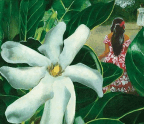The Man Who Passes

Christopher Aubrey surely qualifies as the mystery man of early New Zealand painting. Although his works are held in a number of public institutions—including no fewer than 35 in the National Library—very little is known about him. There are no reliable records of his date and place of birth and background, or whether he immigrated to New Zealand. On the other hand, it was noted early on that the highly detailed nature of his drawing of buildings did suggest he may have received some technical training.1 A dated watercolour of Grafton Gully in the Auckland Art Gallery collection indicates Aubrey was active in this country by at least 1868. He subsequently went to the bottom of the South Island, and then systematically worked his way north, producing paintings of natural scenery, towns and settlements, which he sold as he went by means of a form of lottery known as an art union.
Presumably Aubrey’s paintings had a popular appeal, and while contemporary descriptions of his abilities were generally positive, they could come with reservations. described him as ‘an artist of considerable ability’, while another southern paper reported his work to be ‘of high average excellence’. In Pahīatua he was considered ‘a water colour artist of some merit’, and in Wairarapa ‘an artist of more than ordinary accomplishments’. The peripatetic painter’s progress northwards can be traced through his signed paintings and newspaper advertisements. It took him from Riverton to Balclutha (where his paintings were recommended as ‘an excellent present for forwarding to friends at home’ ), Queenstown, Fiordland, Dunedin and Ōamaru. In 1886 a North Otago newspaper claimed that the injection of so much of ‘the poetry of solitude and solemn serenity’ into Aubrey’s painting of Lake Manapōuri had given it ‘a touch of literal fascination’. Pushing on, by 1888 he was in Wellington, where he displayed 50 scenic views, said to be the result of some nine months’ work, and then proceeded to Wairarapa, Whanganui and Palmerston North. He subsequently passed through Taranaki en route to Waikato and Coromandel, and by the early 1900s he was back in Auckland.
You’re reading a preview, subscribe to read more.
Start your free 30 days



